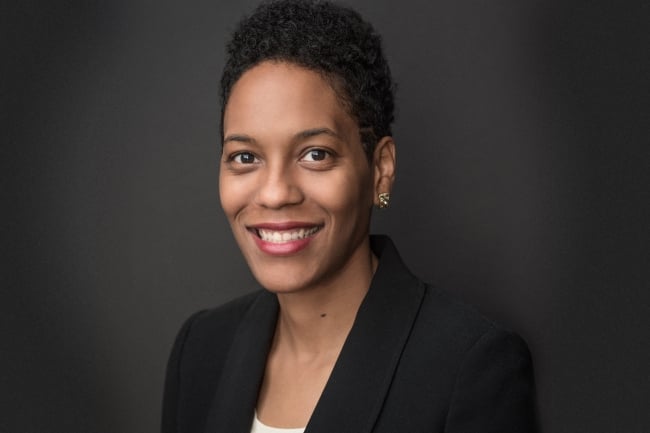You have /5 articles left.
Sign up for a free account or log in.

Despite its challenges, Parnell relishes student affairs work because it intersects with so many aspects of university life.
Robert Hunter
Amelia Parnell, the incoming president of NASPA, a national association for student affairs administrators, is a self-described optimist—but, she stresses, she’s not naïve. After nine years with the organization, where she is currently vice president for research and policy, she knows student affairs isn’t the easiest profession. But what some see as a harrowing moment of change for higher education, she sees as an opportunity for student affairs professionals—who play a role in everything from diversity, equity and inclusion to mental health—to build partnerships, find solutions and continue to make a difference in students’ lives.
She spoke with Inside Higher Ed via phone about her new position, which she begins on July 1. Excerpts of the conversation follow, edited for clarity and length:
Q: As you come into this new position, what do you see as the most pressing challenges facing student affairs professionals at the current moment?
A: I would say there’s a great need right now to provide holistic support for students, and to configure your staff to make sure you can address everything from mental health to advising to conduct and all those things. There’s the cost to do the work—that’s huge; the cost to provide the resource to students, and the cost to operate a division—that’s not getting any cheaper. And when you see things like anti-DEI legislation, and the very professionals who are responsible and energetic and wanting to do that work running up against regulations that say no, that creates a great amount of personal and professional stress and strain. It limits the visibility of work that should be more visible right now.
Q: Can you talk a little more about how anti-DEI legislation impacts students and student affairs professionals?
A: There’s obviously going to be an immediate impact on the learners themselves—the very individuals who are coming to campus and searching and hoping for spaces that affirm their identities. To not have that is a huge loss for students who will thrive in college more when those things are there. For professionals who have roles that are literally in charge of diversity, equity and inclusion programming and initiatives, it impacts them because their jobs may be lost or changed. That’s very hard; when you’ve committed yourself to a profession, you expect it to be there. I also don’t want to miss the fact that many who are in those roles hold the very same identities of the students they’re trying to serve. And to see someone say, in literal print, “You’re not allowed to do your day-to-day work,” is almost asking you to not acknowledge a part of your own identity which you’re very proud and happy to share in service to a university.
Q: We’ve reported on student affairs workers grappling with whether to stay in states pursuing anti-DEI legislation to support students, or to move to more welcoming states. Does NASPA have any advice for individuals in those situations?
A: I’ve heard those same anecdotes and examples. And more than anything, one of the biggest losses for me right now is to see professionals who’ve had longstanding careers doing very dedicated work in this area now feel as though there is not a path forward for them to continue the good work that they know is very impactful for students. I wouldn’t be comfortable giving advice to anyone individually about what they should do. But what I can say is that’s not an uncommon set of questions for anybody who’s involved in this work right now.
Q: You mentioned holistic student support, which is a strategy that’s growing in popularity. Are we at a moment when it might be the best practice, but there are implementation challenges because of the cost?
A: There are a lot of things that we know are essential for students to be successful in college. They need academic support in the classroom as well as resources outside the classroom—tutoring, coaching, mentoring or advising. They have financial obligations—everything from them being able to complete the FAFSA, if they need that, to understanding the repayment process for student loans, or getting an on-campus job. The third is health and well-being—things that relate not only to students in crisis, but also to those navigating periods of stress or strain. Add to that their career preparation, and also their social integration: are they able to make friends and form networks and be a part of clubs and activities and see a social path forward?
If I were that student, and you were to assign to me someone who every week would call and check on me, just to say, “Hey, are you navigating NASPA University well? Are you making friends? Are you finding paths to feel comfortable here?” And then the next week someone calls to check and see how I’m doing with my classes, and then someone asks “How are you doing financially, are your budgets lining up?” If I could do that, I probably could ensure that Amelia Parnell will do just fine in college because I have a lot of support. And it’s very holistic, because the questions that they’re asking me about my financial position also relate to my career aspirations and to how I’m doing academically. Holistic just means they’re not in silos; it means that I pretty much have a care team who is checking on me all the time. But what if there are 40,000 students? To provide all of that at scale comes at a cost. And if you can’t do it for every student, how do you determine which ones should get it?
Q: Regarding mental health and wellbeing, what do you perceive as the biggest issues on campus right now?
A: Mental health is in a space of crisis simply because there’s a great need for more resources and attention than we probably have supply. But I do think there’s some nuance, a continuum that might go from supporting students who are in immediate crisis to helping students address their overall health and wellbeing. From a strategic standpoint, campuses have to make decisions: How much staffing do they need? How many resources do they want to put in per term? What external partnerships and relationships with the community can they use to help address that need? And what other types of things can they do to get students involved and understanding the suite of resources that are available?
The bright spot in this challenge is that it is so big that there’s space for a lot of professionals across the campus, regardless of function, to get involved. I think it’s still something that student affairs will probably lead. But I liked the idea of new partnerships between student affairs and faculty to address mental health needs
Q: Is there a role for artificial intelligence in student affairs?
A: We’re about to start some new research on how campuses are leveraging AI to do things, specifically support services. Most of the conversations have usually fallen into two buckets, one of which is how AI impacts our efficiencies. What can we do more swiftly now? Does that have an implication for personnel? The other questions that come up are about authenticity of the work: Can AI replace things that used to be done? And how do we know that what it produces is as accurate as what we want it to be?
Regardless, I think the biggest bright spot is that we’re at a place almost like when we first realized the internet was not going away; at some point, you have concerns, but then it shifts slowly into a space of, “Let’s try it, let’s see what we can do.” What’s probably going to emerge within student services is it’s not going to replace human decision-making; if anything, it helps us do some things that used to be very tactical or transactional, and leaves more room for the relational. I can see a scenario in which maybe an advising area leverages AI to make their chatbot system even better. So some of the early triage questions—like, “How do I register for this?” or “How do I sign up for that?”—can be managed pretty easily through AI. That leaves more time when you meet with your adviser to [discuss] more holistic questions.
Q: What other kind of research is NASPA looking into?
A: We’re always interested in the advising experience, helping students make decisions around their financial future, academic progress, career decisions, things like that. We have a really great team that’s digging into some of the nuances of advising, and we have for several years. But we’re doing a bit of a refresh, to look specifically at everything from how technology is being leveraged [by] professionals in the role to what types of resources they need and how is advising fitting into things that faculty are doing? And then we still look at trends; we have been tracking anti-DEI legislation very closely. We follow what’s happening in the states and we try to use that to see what the emerging questions are—not just for our membership but for student affairs in general—and how we can be supportive and provide some resources to help them better understand the nuances of this type of movement.
Q: What are you most excited about in your new role?
A: Honestly, I think what excites me most are the same things that excited me earlier in my tenure. Student affairs can connect to everything from anti-DEI legislation to mental health to holistic student support and AI. I like that it is always relevant, always has something to offer, and has a very influential role in everything from policy to discussions of practice to research and scholarship. For someone like me who’s naturally nerdy, it’s a wonderful place to be. There’s no shortage of topics; we didn’t even get into Title IX and conduct and all the other things floating around.
Second, it’s the people. NASPA is a membership association—we’re getting close to 14,000 members—filled with some of the most energetic, passionate, just truly talented, smart, innovative …professionals who, amid all these challenges, come back with success stories about how they’ve met a need in a critical time [and] been able to really transform what students experience on campus. That kind of energy just excites me.
I still maintain this is one of the most difficult times to be working in higher education and in student affairs, but it’s also one of the most opportune. The value and impact of student affairs right now is going to become even more obvious. It also opens the door … for lots more partnerships. I love conversations about how student affairs connects to academic affairs, to IT, to business and finance. I’ve been put into a spot that lets me have access to some of the most emerging conversations with some of the most influential professionals and dedicated campus leaders, and I get to do that every day.








